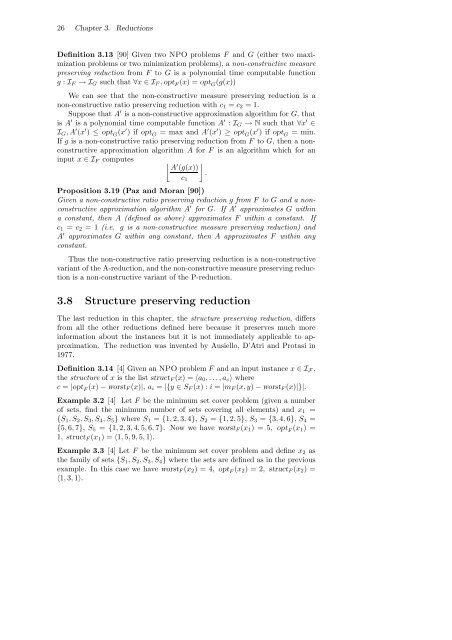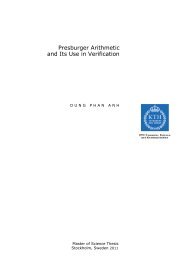On the Approximability of NP-complete Optimization Problems
On the Approximability of NP-complete Optimization Problems
On the Approximability of NP-complete Optimization Problems
You also want an ePaper? Increase the reach of your titles
YUMPU automatically turns print PDFs into web optimized ePapers that Google loves.
26 Chapter 3. Reductions<br />
Definition 3.13 [90] Given two <strong>NP</strong>O problems F and G (ei<strong>the</strong>r two maximization<br />
problems or two minimization problems), a non-constructive measure<br />
preserving reduction from F to G is a polynomial time computable function<br />
g : IF →IG such that ∀x ∈IF , opt F (x) =opt G(g(x))<br />
We can see that <strong>the</strong> non-constructive measure preserving reduction is a<br />
non-constructive ratio preserving reduction with c1 = c2 =1.<br />
Suppose that A ′ is a non-constructive approximation algorithm for G, that<br />
is A ′ is a polynomial time computable function A ′ : IG → N such that ∀x ′ ∈<br />
IG,A ′ (x ′ ) ≤ opt G (x ′ )ifopt G = max and A ′ (x ′ ) ≥ opt G (x ′ )ifopt G =min.<br />
If g is a non-constructive ratio preserving reduction from F to G, <strong>the</strong>n a nonconstructive<br />
approximation algorithm A for F is an algorithm which for an<br />
input x ∈IF computes A ′ (g(x))<br />
c1<br />
Proposition 3.19 (Paz and Moran [90])<br />
Given a non-constructive ratio preserving reduction g from F to G and a nonconstructive<br />
approximation algorithm A ′ for G. If A ′ approximates G within<br />
a constant,<strong>the</strong>n A (defined as above) approximates F within a constant. If<br />
c1 = c2 =1(i.e. g is a non-constructive measure preserving reduction) and<br />
A ′ approximates G within any constant,<strong>the</strong>n A approximates F within any<br />
constant.<br />
Thus <strong>the</strong> non-constructive ratio preserving reduction is a non-constructive<br />
variant <strong>of</strong> <strong>the</strong> A-reduction, and <strong>the</strong> non-constructive measure preserving reduction<br />
is a non-constructive variant <strong>of</strong> <strong>the</strong> P-reduction.<br />
3.8 Structure preservingreduction<br />
The last reduction in this chapter, <strong>the</strong> structure preserving reduction, differs<br />
from all <strong>the</strong> o<strong>the</strong>r reductions defined here because it preserves much more<br />
information about <strong>the</strong> instances but it is not immediately applicable to approximation.<br />
The reduction was invented by Ausiello, D’Atri and Protasi in<br />
1977.<br />
Definition 3.14 [4] Given an <strong>NP</strong>O problem F and an input instance x ∈IF ,<br />
<strong>the</strong> structure <strong>of</strong> x is <strong>the</strong> list structF (x) =〈a0,...,ac〉 where<br />
c = |opt F (x) − worstF (x)|, ai = |{y ∈ SF (x) :i = |mF (x, y) − worstF (x)|}|.<br />
Example 3.2 [4] Let F be <strong>the</strong> minimum set cover problem (given a number<br />
<strong>of</strong> sets, find <strong>the</strong> minimum number <strong>of</strong> sets covering all elements) and x1 =<br />
{S1,S2,S3,S4,S5} where S1 = {1, 2, 3, 4}, S2 = {1, 2, 5}, S3 = {3, 4, 6}, S4 =<br />
{5, 6, 7}, S5 = {1, 2, 3, 4, 5, 6, 7}. Now we have worstF (x1) =5, opt F (x1) =<br />
1, structF (x1) =〈1, 5, 9, 5, 1〉.<br />
Example 3.3 [4] Let F be <strong>the</strong> minimum set cover problem and define x2 as<br />
<strong>the</strong> family <strong>of</strong> sets {S1,S2,S3,S4} where <strong>the</strong> sets are defined as in <strong>the</strong> previous<br />
example. In this case we have worstF (x2) =4, opt F (x2) =2, structF (x2) =<br />
〈1, 3, 1〉.<br />
<br />
.

















